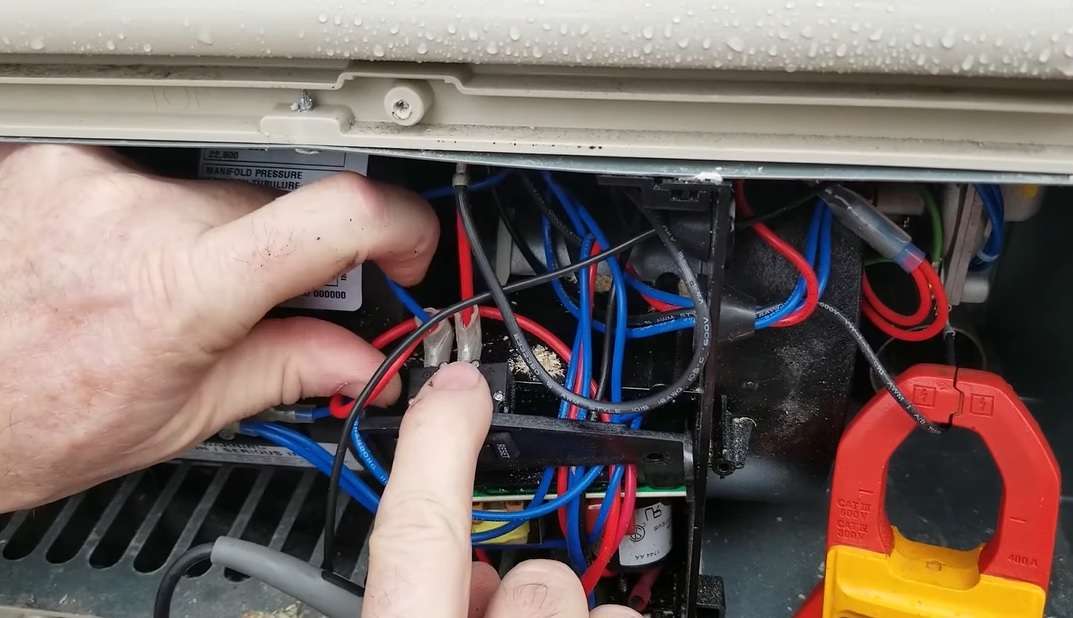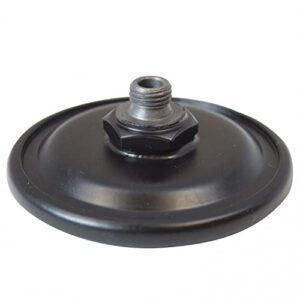The Coleman RV thermostat wiring color code is an important aspect of properly installing and connecting the thermostat in your RV. It is essential to follow the specific color coding scheme to ensure the accurate and effective functioning of the thermostat.
When wiring the Coleman RV thermostat, the common color coding is as follows:
Red for the 12v power supply, Yellow for the compressor, Green for the fan, and White for the furnace.
It is crucial to consult the user manual or seek professional assistance to ensure proper wiring and prevent any potential issues or damage.
Following the correct color code will help ensure the smooth operation of your RV’s thermostat.
Table of Contents
How RV Thermostats Work
RV thermostats are essential components in the comfort and functionality of your Coleman RV. They regulate temperature and help create a cozy environment while you’re on the road.

Understanding how RV thermostats work can give you better control over your heating and cooling systems.
In this section, we will explore the different types of RV thermostats and dive into their basic functioning.
Different Types Of RV Thermostats:
- Mechanical thermostats: These are the simplest and most basic type of RV thermostats. They have a simple dial or slider mechanism that allows you to adjust the temperature manually.
They are reliable and easy to use but lack advanced features like programming and remote control. - Digital thermostats: Unlike mechanical thermostats, digital thermostats offer more precise temperature control with their digital displays.
They typically come with additional features like programmable schedules, allowing you to set different temperatures for specific times of the day or days of the week.
Some models even provide wireless connectivity, enabling remote control via a smartphone app. - Smart thermostats: The latest innovation in rv thermostat technology, smart thermostats combine the convenience of digital thermostats with advanced connectivity features.
They can be controlled remotely through your smartphone, tablet, or computer, no matter where you are.
Smart thermostats also often include energy-saving features such as learning algorithms that adapt to your RV’s temperature preferences over time.
Basic Functioning Of An RV Thermostat:
- Temperature sensing: RV thermostats use sensors to detect the temperature within your RV. They can be located within the thermostat unit itself or in a remote location, depending on the thermostat type.
- Temperature adjustment: Once the thermostat senses the current temperature, it compares it to the desired temperature set by the user.
If the actual temperature is lower than the set temperature, the thermostat signals the heating system to activate.
If the actual temperature is higher, it communicates with the cooling system to kick in. - System control: RV thermostats play a crucial role in controlling the heating and cooling systems in your RV.
They relay signals to the furnace, air conditioner, or heat pump, instructing them to turn on or off based on the temperature readings. - Fan control: Many RV thermostats also provide control over the fan, allowing you to adjust its speed or set it to auto mode. This feature is especially useful during the cooling season when you want the fan to circulate the cool air more efficiently.
Understanding the different types of RV thermostats and their basic functioning can help you choose the right thermostat for your Coleman RV and maximize your comfort on the road.
Whether you prefer a simple mechanical thermostat or a feature-packed smart thermostat, there’s a wide range of options available to suit your needs.
So, let’s dive deeper and explore the wiring color codes specifically for Coleman RV thermostats in our next section.
Decoding The Wiring Color Code
The Significance Of Wiring Color Codes In RV Thermostats
RV thermostats play a crucial role in maintaining a comfortable temperature inside your vehicle. However, understanding the wiring color code is equally important to ensure a smooth and hassle-free installation process.
Wiring color codes act as a guide, helping you connect the right wires to the corresponding terminals.
By decoding these codes, you can easily identify and connect the necessary wires, making it easier to troubleshoot any future issues.
Importance Of Understanding The Coleman RV Thermostat Color Code
Understanding the Coleman RV thermostat color code is essential for the proper installation and maintenance of your thermostat. Here’s why it’s important:
- Avoid wiring mishaps: The Coleman RV thermostat color code helps prevent wiring mishaps that can result in malfunctioning or damaged thermostats.
When you understand the color code, you can correctly connect the wires to their respective terminals, ensuring proper functionality and preventing any electrical accidents. - Troubleshooting made easier: At some point, you might encounter issues with your RV thermostat. By understanding the wiring color code, troubleshooting becomes much easier.
You’ll have a clear idea of which wire connects to which terminal, allowing you to identify potential problems and make necessary repairs or replacements promptly. - Compatibility with other systems: If you plan to upgrade or replace your RV thermostat, understanding the Coleman wiring color code is crucial.
Different thermostat models may use different color codes, so having a good grasp of the Coleman color code will ensure compatibility with other systems in your RV.
Common Color Codes Used In Coleman RV Thermostat Wiring
The Coleman RV thermostat color code follows a standard convention, making it easier for you to identify and connect the wires correctly.
Here are the common color codes used in Coleman RV thermostat wiring:
- Red wire: Typically connected to the r or rh terminal, the red wire carries the 12-volt power supply to the thermostat.
- Yellow wire: The yellow wire is responsible for controlling the cooling function of the RV’s air conditioner. It is usually connected to the y or y1 terminal.
- Green wire: Connected to the g terminal, the green wire controls the fan operation in the RV’s air conditioning system.
- White wire: The white wire is used for controlling the heating function of the RV’s furnace and is typically connected to the w or w1 terminal.
- Blue wire: Although not always present, the blue wire is sometimes used to power the heating system and is connected to the c or common terminal.
Understanding these color codes will make it easier for you to connect your Coleman RV thermostat correctly and ensure optimal performance.
Remember to always consult the specific manufacturer’s documentation for your particular RV thermostat model to ensure accurate and safe wiring connections.
Coleman Rv Thermostat Wiring Guide
If you’re looking to wire up your Coleman RV thermostat, it’s important to understand the color code and proper connections.
In this Coleman RV thermostat wiring guide, we’ll walk you through the step-by-step process of identifying thermostat wires, mapping the wiring connections, and properly connecting the wires.
Safety is key, so we’ll also cover how to secure the connections for a worry-free experience.
Step-By-Step Instructions For Wiring A Coleman RV Thermostat:
- Identify the wires: The first step is to identify the different wires in your thermostat system. Each wire is usually labeled with a specific color to indicate its function.
- Turn off the power: Before working on any electrical components, make sure to turn off the power supply to avoid any accidents.
- Map the wiring connections: Once you have identified the wires, create a diagram or take a picture to map out the current wiring connections. This will help you ensure that the new thermostat is wired correctly.
- Label the wires: It’s always a good idea to label each wire based on its color and corresponding terminal. This will make it easier to connect the wires correctly to the new thermostat.
- Install the new thermostat: Remove the old thermostat and install the new one according to the manufacturer’s instructions. Make sure to follow the correct wiring configuration as indicated in your diagram or picture.
- Connect the wires: Connect each wire to its corresponding terminal on the new thermostat. Double-check that each wire is securely fastened to prevent any loose connections.
- Test the thermostat: Once all the wires are connected, turn the power back on and test the thermostat to ensure it’s functioning properly. Check if the heating, cooling, and fan settings work as expected.
- Secure the connections: After testing, it’s important to secure the connections by using electrical tape or wire connectors. This will prevent any accidental disconnections or short circuits.
- Reassemble and clean up: Finally, reassemble any covers or panels that were removed during the installation process. Clean up any debris or tools used to ensure a neat and tidy finish.
By following these step-by-step instructions for wiring your Coleman RV thermostat, you’ll be able to confidently complete the task and enjoy a comfortable and well-regulated RV temperature.
Safety should always be the top priority, so be sure to handle electrical components with caution and consult a professional if needed.
Now that you have a better understanding of the process, let’s get started!
Common Wiring Issues & Troubleshooting
Troubleshooting Common Wiring Problems In Coleman RV Thermostats
When it comes to your Coleman RV thermostat, understanding the wiring color code and troubleshooting common wiring issues is crucial.
Faulty wires or connections can cause your thermostat to malfunction, leading to issues with temperature control in your RV.
In this section, we will discuss a few common wiring problems that you may encounter and provide some tips on how to fix them.
Identifying Faulty Wires Or Connections:
- Loose connections: Check for loose connections in the wiring terminals of your thermostat. Tighten any loose wires to ensure a secure connection.
- Damaged wires: Inspect the thermostat wires for any signs of damage, such as frayed or exposed wires. If you find any damage, replace the affected wires to prevent further issues.
- Incorrectly connected wires: Double-check the wiring connections in your thermostat against the manufacturer’s wiring color code. Any mismatched or incorrectly connected wires should be corrected to ensure proper functionality.
Tips For Fixing Wiring Issues In The Thermostat:
- Reset the thermostat: Sometimes, a simple reset can solve minor wiring issues. Turn off the power to your thermostat, wait a few minutes, and then turn it back on. This can help reset the thermostat and resolve any temporary glitches.
- Consult the wiring diagram: If you are unsure about the wiring connections in your Coleman RV thermostat, refer to the wiring diagram provided by the manufacturer. This diagram will guide you in correctly connecting the wires based on their color code.
- Use wire connectors: To ensure secure and reliable connections, use wire connectors or wire nuts to join the thermostat wires. This will prevent any loose or exposed wires from causing wiring problems in the future.
- Seek professional help if needed: If you are uncomfortable or unsure about troubleshooting and fixing wiring issues in your Coleman RV thermostat, it is best to seek the assistance of a qualified technician. They have the expertise and tools necessary to diagnose and resolve complex wiring problems.
By understanding the common wiring problems that can occur in Coleman RV thermostats and following these troubleshooting tips, you can ensure smooth operation and efficient temperature control in your RV.
Remember to always prioritize safety and consult the manufacturer’s guidelines for specific instructions related to your thermostat model.
Upgrading Your RV Thermostat
RV thermostats are a crucial element in ensuring your comfort while on the road. If you have a Coleman RV, upgrading to a modern thermostat can provide several benefits and enhance your overall camping experience.
This section will explore the benefits of upgrading, compatible thermostat options for Coleman RVs, and rewiring considerations.
Benefits Of Upgrading To A Modern RV Thermostat:
- Enhanced temperature control: Modern RV thermostats offer precise temperature regulation, allowing you to achieve your desired comfort level easily.
- Energy efficiency: Upgrading to a modern thermostat can help you optimize energy usage, potentially reducing heating and cooling costs during your trips.
- Programmable settings: Many modern thermostats come with programmable features, enabling you to set temperature schedules based on your daily routine. This ensures that your RV is always comfortable when you return after a day of exploration.
- Digital display: Unlike older thermostat models with analog dials, modern rv thermostats feature digital displays that provide easy-to-read temperature information.
- Compatibility with smart technology: Some newer thermostats can be integrated with smart home systems, allowing you to control the temperature remotely or through voice commands.
Compatible Thermostat Options For Coleman RVs:
If you own a Coleman RV and are considering an upgrade, here are some compatible thermostat options to consider:
- Coleman Mach 10 thermostats: Specifically designed for Coleman RVs, this thermostat offers advanced features such as a backlit LCD screen and compatibility with remote controls.
- Honeywell rth5100b digital thermostat: This thermostat is compatible with most RV systems, including Coleman, and comes with a user-friendly interface and battery backup.
- Ecobee smart thermostat: Although not specifically designed for Coleman RVs, the Ecobee smartthermostat offers versatility and integration with smart home systems.
Rewiring Considerations And Compatibility With Existing Systems:
When upgrading your RV thermostat, it’s important to consider rewiring and compatibility with your existing system.
Here are a few points to keep in mind:
- Wiring color code: Understanding the wiring color code for your Coleman RV is crucial during the rewiring process. Ensure that you choose a thermostat that is compatible with your RV’s existing wiring color scheme.
- Wiring compatibility: Different thermostat models may have different wiring requirements. Before purchasing a new thermostat, check its compatibility with your RV’s wiring system.
- Professional installation: If you’re uncertain about rewiring or compatibility, it’s recommended to seek the assistance of a professional RV technician. They can ensure the proper installation of your new thermostat and address any compatibility issues.
Upgrading your RV thermostat can have a significant impact on your camping experience, offering improved temperature control, energy efficiency, and convenience.
Consider the benefits of upgrading and explore compatible thermostat options for your Coleman RV.
To ensure a smooth transition, take into account rewiring considerations and seek professional help if needed.
Enjoy a more comfortable and enjoyable time on the road with a modern rv thermostat.
Safety Precautions And Best Practices
Important Safety Measures When Working With Thermostat Wiring:
Working with thermostat wiring requires careful attention to safety precautions to ensure the smooth installation and operation of an RV thermostat system.
Here are some important safety measures to keep in mind:
- Always shut off the power: Before you begin working with thermostat wiring, make sure to turn off the power to the RV. This will help prevent electric shocks and other electrical accidents.
- Proper insulation and protection: When handling thermostat wiring, ensure that all wires are properly insulated and protected from any potential damage. Inspect the wiring for any signs of wear, fraying, or other issues that could compromise safety.
- Use proper tools and equipment: It’s crucial to use the right tools and equipment when working with thermostat wiring. This includes wire strippers, wire connectors, and a voltage tester to ensure that all connections are secure and in good working order.
- Consult the manufacturer’s guide: Every RV thermostat system may have specific instructions and guidelines for installation. It is essential to refer to the manufacturer’s guide to follow the correct wiring color code and ensure proper installation.
- Take pictures and label wires: Before disconnecting any wires, take pictures or make clear notes of their original positions. This will help you reconnect them correctly during the installation process. Additionally, labeling the wires with their corresponding colors is a helpful practice for future reference.
Proper Grounding Techniques For RV Thermostat Installation:
Proper grounding is vital for the safe and effective operation of an RV thermostat system.
Here are some essential techniques to follow when grounding the thermostat:
- Locate a solid grounding point: Find a suitable grounding point within the RV that offers a secure and low-resistance connection. Ideally, this is a metal surface or the designated grounding point specified by the manufacturer.
- Remove any paint or corrosion: Before securing the grounding wire, ensure that the selected surface is free of paint, rust, or corrosion. This will ensure better electrical conductivity.
- Use the correct wire size: When connecting the grounding wire, make sure it has the appropriate gauge size. Refer to the manufacturer’s instructions to determine the correct wire size for your specific RV thermostat system.
- Tighten connections securely: To create a reliable ground connection, ensure that all grounding wires are tightly secured. Loose connections can lead to electrical issues and potentially compromise the safety of the system.
Remember, safety should always be the top priority when working with thermostat wiring.
By following these safety precautions and proper grounding techniques, you can ensure a safe installation and optimal performance of your RV thermostat system.
Related Questions About Coleman RV Thermostat Wiring
If you’re a proud owner of an RV equipped with a Coleman thermostat, you may have questions about its wiring and color coding.
Understanding how the thermostat wiring works is essential for proper functioning and troubleshooting.
Below, we’ve compiled some of the most commonly asked questions about Coleman RV thermostat wiring, along with expert answers and solutions.
Common Questions Related To Coleman RV Thermostat Wiring Color Code
Here are some frequently asked questions regarding the Coleman RV thermostat wiring color code:
What do the different thermostat wiring colors signify?
- Red: Typically used for connecting to the 12v DC power supply.
- Yellow: Connects to the compressor unit for cooling.
- Green: Connects to the fan relay for controlling the blower fan.
- White: Connects to the heating system.
- Blue: Commonly used as the c-wire, providing continuous power to the thermostat
What should I do if my thermostat wiring colors don’t match the standard?
If the wiring colors in your Coleman RV thermostat do not align with the standard color code mentioned earlier, you may need to identify the function of each wire by checking the manufacturer’s documentation or using a multimeter.
Once you determine the function of each wire, you can proceed with the installation or troubleshooting accordingly.
Can I use wire labels instead of relying on colors?
Absolutely! Using wire labels is a great way to avoid confusion and ensure accurate connections. Simply affix labels to each wire, indicating its function, and match them accordingly with the thermostat terminals or HVAC unit.
How can I troubleshoot common thermostat wiring issues?
- Ensure all wires are tightly connected to their respective terminals.
- Verify that the power is properly supplied to the thermostat.
- Check for any visible damage or frayed wires.
- Use a multimeter to test the continuity and voltage of each wire.
- Consult the manufacturer’s manual for specific troubleshooting steps.
Are there any safety precautions to keep in mind while working with thermostat wiring?
Yes, safety should always be a priority. Here are some precautions to consider:
- Disconnect the power source before starting any wiring work.
- Use insulated tools to prevent electrical shocks.
- Double-check the wiring connections before turning on the power.
- If unsure or uncomfortable, consult a professional electrician or HVAC technician.
Understanding the Coleman RV thermostat wiring color code is crucial for proper installation and troubleshooting.
By following the standard color indications or using wire labels, you can ensure the correct connections.
If any issues arise, it’s best to refer to the manufacturer’s documentation or seek professional assistance.
FAQ’s
What Are The Common Rv Thermostat Wire Colors?
The common rv thermostat wire colors are red, yellow, green, white, and blue.
How Do I Determine The Correct Thermostat Wire Color Code?
To determine the correct thermostat wire color code, refer to the installation instructions or the manual provided by the manufacturer.
Can I Use Any Thermostat Wire Color For My RV?
No, it is important to use the correct thermostat wire color as specified by the manufacturer to ensure proper functionality.
What Happens If I Wire The Thermostat Incorrectly?
Wiring the thermostat incorrectly can result in improper temperature control or even damage to the thermostat or other components of the RV’s heating and cooling system.
Are There Any Safety Precautions To Follow When Wiring The Thermostat?
Yes, always make sure to turn off the power to the RV before working on any wiring to avoid the risk of electrical shock or damage to the system.
Can I Hire A Professional To Wire My RV thermostat?
Yes, if you are unsure or uncomfortable with wiring the thermostat yourself, it is recommended to hire a professional to ensure proper installation and avoid any potential issues.
Conclusion
Understanding the Coleman RV thermostat wiring color code is essential for installing or troubleshooting your RV’s heating and cooling system.
By knowing which wires correspond to specific functions, you can effectively connect or diagnose any issues that arise.
The color code consists of red for the power supply, yellow for the compressor, blue for the AC fan, green for the furnace fan, and white for the furnace heat.
This standardized system ensures accurate wiring connections and simplifies the process for both professionals and DIY enthusiasts.
Remember to always follow safety guidelines and consult the appropriate manuals to ensure proper installation and functionality.
With a solid grasp of the Coleman RV thermostat wiring color code, you can confidently maintain a comfortable environment in your RV, wherever your travels take you




